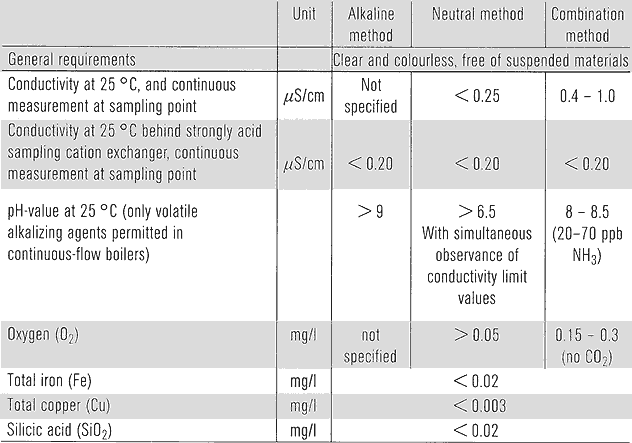| Feed water treatment | ||
The predominant material in steam boiler systems is steel, which is attacked by water and steam. Yet under suitable conditions this attack gives rise to a protective composite layer with the steel substratum, which has a self-arresting effect on the corrosion process. It is necessary, therefore, for the feed water to fulfill certain requirements in order to ensure the safe operation of such boiler systems. A distinction, based on the conditioning agents used, is drawn between three main types of water treatment: 1. Conditioning with alkalizing agents (alkaline method) entails: Operating with feed water and boiler water whose pH-value is raised by alkalizing agents. 2. Conditioning with oxidizing agents (neutral method) entails: Operating with neutral salt-free feed water, to which oxygen or hydrogen peroxide is added as oxidizing agent. 3. Conditioning with alkalizing and oxidizing agents (combined method) entails: Operating with saltfree feed water, whose pH-value is raised with ammonia and to which oxygen is added as well. Further influencing variables are:
|
Following guide values apply for saltfree feed water for continuous-flow and forced-circulation boilers ³ 64 bar (table below): The requirements placed on boiler water in the case of saltfree feed water and those for saline feed water are specified in the regulations quoted below the table. Effects on the mechanical seal
With a falling pH-value, rising O2 content and increasing sliding velocity of the seal, selective corrosion/erosion effects on face materials made of nickel- and cobalt-bonded tungsten carbides and metalimpregnated carbon graphites limit the service life. This is remedied by using silicon carbide and resin impregnated carbons.
Precipitation of salt in the zone near the seal and in the area of the sliding faces lead to increased wear as well as to leakage through restricted movement of the seals. |
|
 Literature: I) "The combined ammonia/oxygen conditioning of the water steam circuit of block systems with continuous-flow steam generators (combination method)" published in Der Maschinenschaden 53 (1980), issue 6, pages 217/246. 2) "VGB guidelines for boiler feed water, boiler water and steam from water tube boilers in pressure stages of 64 bar and above", October 1980 edition. 3) Technical regulation for steam boilers 611: Operation – feed water and boiler water of steam generators in Group IV, June I981. |
||